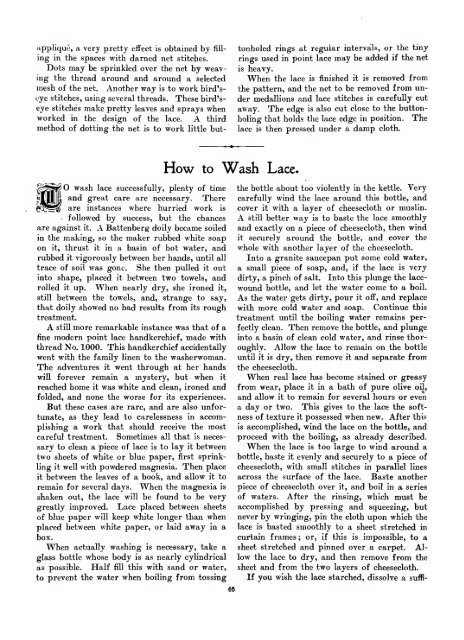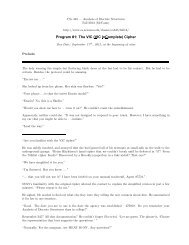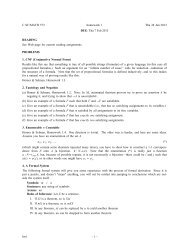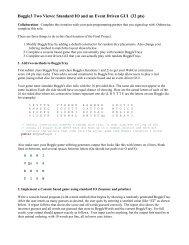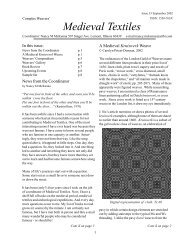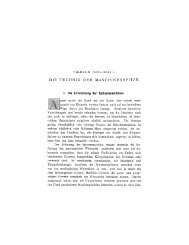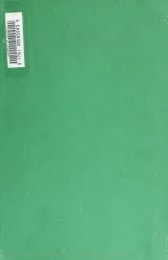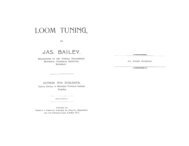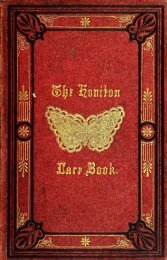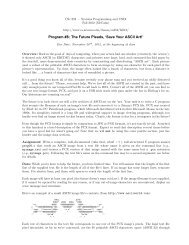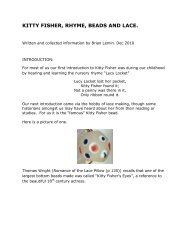The Priscilla Battenberg and point lace book; a collection of lace ...
The Priscilla Battenberg and point lace book; a collection of lace ...
The Priscilla Battenberg and point lace book; a collection of lace ...
Create successful ePaper yourself
Turn your PDF publications into a flip-book with our unique Google optimized e-Paper software.
applique, a very pretty effect is obtained by. filling<br />
in the spaces with darned net stitches.<br />
Dots may be sprinkled over the net by weaving<br />
the thread around <strong>and</strong> around a selected<br />
mesh <strong>of</strong> the net. Another way is to work bird's-<br />
eye stitches, using several threads. <strong>The</strong>se bird'seye<br />
stitches make pretty leaves <strong>and</strong> sprays when<br />
worked in the design <strong>of</strong> the <strong>lace</strong>. A third<br />
method <strong>of</strong> dotting the net is to work little but-<br />
'O wash <strong>lace</strong> successfully, plenty <strong>of</strong> time<br />
<strong>and</strong> great care are necessary. <strong>The</strong>re<br />
. followed<br />
are instances where hurried work is<br />
by success, but the chances<br />
are against it. A <strong>Battenberg</strong> doily became soiled<br />
in the making, so the maker rubbed white soap<br />
on it, thrust it in a basin <strong>of</strong> hot water, <strong>and</strong><br />
rubbed it vigorously between her h<strong>and</strong>s, until all<br />
trace <strong>of</strong> soil was gone. She then pulled it out<br />
into shape, p<strong>lace</strong>d it between two towels, <strong>and</strong><br />
rolled it up. When nearly dry, she ironed it,<br />
still between the towels, <strong>and</strong>, strange to say,<br />
that doily showed no bad results from its rough<br />
treatment.<br />
A still more remarkable instance was that <strong>of</strong> a<br />
fine modern <strong>point</strong> <strong>lace</strong> h<strong>and</strong>kerchief, made with<br />
thread No. 1000. This h<strong>and</strong>kerchief accidentally<br />
went with the family linen to the washerwoman.<br />
<strong>The</strong> adventures it went through at her h<strong>and</strong>s<br />
will forever remain a mystery, but when it<br />
reached home it was white <strong>and</strong> clean, ironed <strong>and</strong><br />
folded, <strong>and</strong> none the worse for its experiences.<br />
But these cases are rare, <strong>and</strong> are also unfortunate,<br />
as they lead to carelessness in accomplishing<br />
a work that should receive the most<br />
careful treatment. Sometimes all that is necessary<br />
to clean a piece <strong>of</strong> <strong>lace</strong> is to lay it between<br />
two sheets <strong>of</strong> white or blue paper, first sprink-<br />
ling it well with powdered magnesia. <strong>The</strong>n p<strong>lace</strong><br />
it between the leaves <strong>of</strong> a <strong>book</strong>, <strong>and</strong> allow it to<br />
remain for several daj's. When the magnesia is<br />
shaken out, the <strong>lace</strong> will be found to be very<br />
greatly improved. Lace p<strong>lace</strong>d between sheets<br />
<strong>of</strong> blue paper will keep white longer than when<br />
p<strong>lace</strong>d between white paper, or laid away in a<br />
box.<br />
When actually washing is necessary, take a<br />
glass bottle whose body is as nearly cylindrical<br />
as possible. Half fill this with s<strong>and</strong> or water,<br />
to prevent the water when boiling from tossing<br />
How to Wash Lace.<br />
46<br />
tonholed rings at regular intervals, or the tiny<br />
rings used in <strong>point</strong> <strong>lace</strong> may be added if the net<br />
is heavy.<br />
When the <strong>lace</strong> is finished it is removed from<br />
the pattern, <strong>and</strong> the net to be removed from un-<br />
der medallions <strong>and</strong> <strong>lace</strong> stitches is carefully cut<br />
away. <strong>The</strong> edge is also cut close to the buttonholing<br />
that holds the <strong>lace</strong> edge in position. <strong>The</strong><br />
<strong>lace</strong> is then pressed under a damp cloth.<br />
the bottle about too violently in the kettle. Very<br />
carefully wind the <strong>lace</strong> around this bottle, <strong>and</strong><br />
cover it with a layer <strong>of</strong> cheesecloth or muslin.<br />
A still better way is to baste the <strong>lace</strong> smoothly<br />
<strong>and</strong> exactly on a piece <strong>of</strong> cheesecloth, then wind<br />
it securely around the bottle, <strong>and</strong> cover the<br />
whole with another layer <strong>of</strong> the cheesecloth.<br />
Into a granite saucepan put some cold water,<br />
a small piece <strong>of</strong> soap, <strong>and</strong>, if the <strong>lace</strong> is very<br />
dirty, a pinch <strong>of</strong> salt. Into this plunge the <strong>lace</strong>wound<br />
bottle, <strong>and</strong> let the water come to a boil.<br />
As the water gets dirty, pour it <strong>of</strong>f, <strong>and</strong> rep<strong>lace</strong><br />
with more cold water <strong>and</strong> soap. Continue this<br />
treatment until the boiling water remains perfectly<br />
clean. <strong>The</strong>n remove the bottle, <strong>and</strong> plunge<br />
into a basin <strong>of</strong> clean cold water, <strong>and</strong> rinse thor-<br />
oughly. Allow the <strong>lace</strong> to remain on the bottle<br />
until it is dry, then remove it <strong>and</strong> separate from<br />
the cheesecloth.<br />
When real <strong>lace</strong> has become stained or greasy<br />
from wear, p<strong>lace</strong> it in a bath <strong>of</strong> pure olive oil,<br />
<strong>and</strong> allow it to remain for several hours or even<br />
a day or two. This gives to the <strong>lace</strong> the s<strong>of</strong>t-<br />
ness <strong>of</strong> texture it possessed when new. After this<br />
is accomplished, wind the <strong>lace</strong> on the bottle, <strong>and</strong><br />
proceed with the boiling, as already described.<br />
When the <strong>lace</strong> is too large to wind around a<br />
bottle, baste it evenly <strong>and</strong> securely to a piece <strong>of</strong><br />
cheesecloth, with small stitches in parallel lines<br />
across the surface <strong>of</strong> the <strong>lace</strong>. Baste another<br />
piece <strong>of</strong> cheesecloth over it, <strong>and</strong> boil in a series<br />
<strong>of</strong> waters. After the rinsing, which must be<br />
accomplished by pressing <strong>and</strong> squeezing, but<br />
never by wringing, pin the cloth upon which the<br />
<strong>lace</strong> is basted smoothly to a sheet stretched in<br />
curtain frames ; or, if this is impossible, to a<br />
sheet stretched <strong>and</strong> pinned over a carpet. Allow<br />
the <strong>lace</strong> to dry, <strong>and</strong> then remove from the<br />
sheet <strong>and</strong> from the two layers <strong>of</strong> cheesecloth.<br />
If you wish the <strong>lace</strong> starched, dissolve a suflB-


